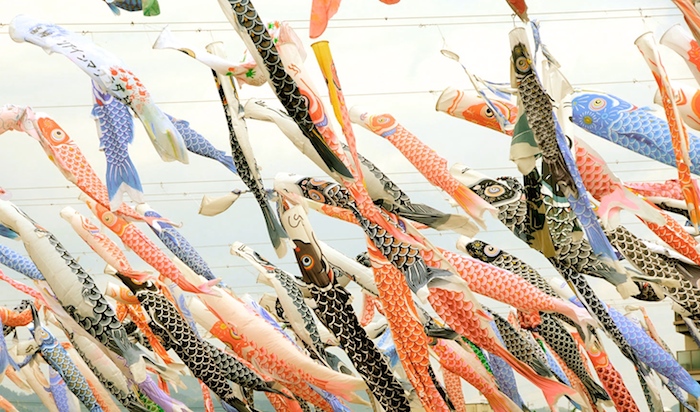Thursday
May082014
Children's Day, 2014
 Thursday, May 8, 2014 at 11:05AM
Thursday, May 8, 2014 at 11:05AM
 Monday, May fifth was Children’s Day, or Kodomo no Hi (こどもの日), here in Japan, one of the four national holidays that form Golden Week.
Monday, May fifth was Children’s Day, or Kodomo no Hi (こどもの日), here in Japan, one of the four national holidays that form Golden Week.
Originally called Tango no Sekku (端午の節句),1 Children’s Day used to be celebrated on the 5th day of the 5th moon in the old lunisolar, or Chinese, calendar, but was switched to May fifth after Japan's adoption of the Gregorian calendar in 1873. The festival is still celebrated in the east Asian countries of China, Taiwan, Hong Kong and Macau, where it is called the Duanwu (or Drangon Boat) Festival (Tuen Ng in Cantonese); Korea (Dano Festival) and Vietnam (Tết Đoan Ngọ).
According to the Chinese calendar, the fifth day of the fifth month usually falls near the summer solstice, when the sun, which represents masculine energy, is considered to be at its strongest, and it was for this reason that Tango no Sekku was also known as Boys' Day. (March 3rd, Hina Matsuri, was and still is called Girls' Day) In 1948, the Japanese government renamed the holiday Kodomo no Hi, decreeing the day to one to celebrate the happiness of all children, not just that of boys.

Well, speaking of children, according to a report released by the Ministry of Internal Affairs and Communications on Children’s Day, the population of children (aged 0 to 14) in Japan was 16,330,000 as of April 1, 2014, or 160,000 less than last year. This marked the 33rd year in a row that the number of children in Japan has fallen. The last time the population of children increased was in 1977. As a proportion of the total population, children now account for only 12.97%, the lowest figure on record.

Taking a closer look at the number of children by age group, we see that if nothing changes in the next few years to increase birthrate then the proportion of children to the total population will continue to drop dramatically.

This graph (pictured above) shows the population of three demographics: blue for those 0-14 years of age; brown for those between the ages of 15 and 64; and green for those 65 and older. As you can see, while the number of those in the middle hasn’t changed very much--indeed, they are at levels today (62.1% of the population) that they were at in 1955 (61.3%)—the number of children has steadily decreased, while the number of elderly has increased. Today, 25.1% of the population is 65 years old or older.
In somewhat related news, the number of stalking cases involving suspects over the age of sixty has continued to rise in recent years. While cases involving suspects between the ages of 20 and 59 have risen 1.5 to 2.0 times over the past ten years, those involving these “silver stalkers” has almost quadrupled.
Although only accounting for a small minority of all stalking cases (less than 10%), the number of incidents committed by stalkers in their sixties is up 3.4 times since 2003, while those perpretrated by stalkers in their 70s have increased 5.6 times.
One man in his eighties, who was arrested for “gatecrashing” into the home of a woman who was in her seventies, confessed to the police that he had been lonely since the death of his wife. After she passed away, the man asked the younger woman, with whom he had once had an affair, to get back together with him, begging her to “die with him”.
I almost feel sorry for the randy old sod.
1 From Wikipedia: "Tan means ‘beginning' and go means ‘horse', referring to the Chinese zodiac name for the fifth lunar month. Sekku means a seasonal festival. There are five sekku, including O-Shogatsu (January 1st), Hina Matsuri (March 3rd), Tanabata (July 7th) and Kiku Matsuri (September 9th) along with Tango. Tango no Sekku marks the beginning of summer or the rainy season."
